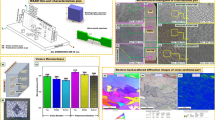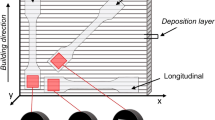Abstract
The structures, mechanical properties and fracture behaviour of inertia-friction welds produced between rapidly-solidified/powder metallurgy (RS/PM) Al-9Fe-3Mo-1V (wt %) and ingot metallurgy (IM) 2024-T351 aluminium were investigated. Visual examination showed the axial displacement experienced by the specimens during welding and the degree of metal expulsion from the weld interface (i.e. “flash”) to increase with an increase in axial force. The weld flash was observed to originate principally from the IM 2024-T351, which was consistent with the lower elevated-temperature strength of this precipitation-hardened alloy. Although the weld interface region remained nearly flat in welds produced using low axial force, this surface became increasingly curved (concave into the Al-9Fe-3Mo-1V alloy) with an increase in axial force. Microstructure analysis using both light and analytical electron microscopy characterized the heat- and deformation-affected zones (HDZs) in each of the base metals and the weld interface regions. The HDZ directly adjacent to the weld interface in the IM 2024-T351 exhibited fine, recrystallized alpha aluminium grains and an absence of S′ precipitates present in the base metal microstructure. The HDZ directly adjacent to the weld interface in the Al-9Fe-3Mo-1V exhibited fine alpha grains and fine, spherical and acicular dispersoids, which in part originated from the plastic deformation and fracture of coarse base metal dispersoid particles. The extent of this dispersoid-refined region was greatest at the centre of the weld as opposed to the outer periphery, and in the low rather than the high axial force weld. At the weld interface in the vicinity of the axial centre line, the occurrence of highly localized mechanical mixing between the two alloys was determined using both light and electron microscopy and electron-microprobe analysis techniques.
Microhardness traverses showed relatively little variation in hardness across the weld interface and an absence of hardness degradation at any location relative to the unaffected base metals. Room-temperature transverse-weld tensile testing showed tensile strengths to range between 85 and 90% of the RS/PM base metal, with fracture occurring in the Al-9Fe-3Mo-1V HDZ remote from the weld interface. Three-point guided bend testing also revealed fracture to occur in the Al-9Fe-3Mo-1V HDZ. SEM fractographic analysis of the fracture surfaces found fracture in the Al-9Fe-3Mo-1V to involve microvoid formation at dispersoid/alpha aluminium interfaces and subsequent ductile rupture in the alpha aluminium matrix.
Similar content being viewed by others
References
W. E. Quist andR. E. Lewis, in “Rapidly Solidified Powder Aluminium Alloys, STP 890”, edited by E. A. Starke Jr and M. E. Fine (American Society for Testing and Materials, Philadelphia, 1986) p. 7.
C. M. Adam andR. G. Bourdeau, in “Rapid Solidification Processing: Principles and Technologies”, edited by R. Mehrabian, B. H. Gear and M. Cohen (Claitors, Baton Rouge, 1980) p. 246.
E. P. Cone andP. M. Komater, in “Exploratory Development of Processing Elevated Temperature Powder Metallurgy Alloys”, (AFWAL-FR-18804-7, 1988) p. 6.
Metals Handbook, 9th edn, Vol. 2 (American Society for Metals, Materials Park, Ohio, 1983) p. 75.
S. Krishnaswamy andW. A. Baeslack III, in “Recent Trends in Welding Science and Technology”, edited by S. A. David and J. M. Vitek (ASM International, Materials Park, Ohio, 1990) p. 631.
W. A. Baeslack III andS. Krishnaswamy, in “Advances in Welding Science and Technology”, edited by S. A. David, (ASM International, Materials Park, Ohio, 1987) p. 357.
W. A. Baeslack III, K. H. Hou andJ. H. Develetian,J. Mater. Sci. Lett. 7 (1988) 944.
W. A. Baeslack III andK. S. Hagey,Weld. J. Res. Suppl. 67 (1988) 139s.
K. H. Hou andW. A. Baeslack III,J. Mater. Sci. 25 (1990) 2642.
S. L. Langenbeck andR. A. Rainen, in “Elevated Temperature Aluminium Alloy Development”, (AFWAL-TR-86-4027, 1986) p. 6.
M. Rao andT. Hazlett,Weld. J. Res. Suppl. 49 (1970) 181s.
Author information
Authors and Affiliations
Rights and permissions
About this article
Cite this article
Koo, H.H., Sampath, K. & Baeslack, W.A. Characterization of inertia-friction welds between a rapidly-solidified Al-Fe-Mo-V alloy and IM 2024-T351. J Mater Sci 27, 3266–3280 (1992). https://doi.org/10.1007/BF01116023
Received:
Accepted:
Issue Date:
DOI: https://doi.org/10.1007/BF01116023




